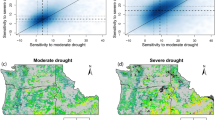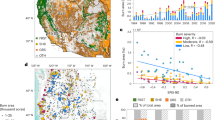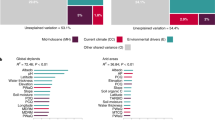Abstract
Forests are increasingly threatened by climate-change-fuelled cycles of drought, dieback and wildfires. However, for reasons that remain incompletely understood, some forest stands are more vulnerable than others, leaving a patchwork of varying dieback and wildfire risk after drought. Here, we show that spatial variability in forest drought response can be explained by differences in underlying bedrock. Our analysis links geochemical measurements of bedrock composition, geophysical measurements of subsurface weathering and remotely sensed changes in evapotranspiration during the 2011–2017 drought in California. We find that evapotranspiration plummeted in dense forest stands rooted in weathered, nutrient-rich bedrock. By contrast, relatively unweathered, nutrient-poor bedrock supported thin forest stands that emerged unscathed from the drought. By influencing both subsurface weathering and nutrient supply, bedrock composition regulates the balance of water storage and demand in mountain ecosystems. However, rather than enhancing forest resilience to drought by providing more water-storage capacity, bedrock with more weatherable and nutrient-rich minerals induced greater vulnerability by enabling a boom–bust cycle in which higher ecosystem productivity during wet years drives excess plant water demand during droughts.
This is a preview of subscription content, access via your institution
Access options
Access Nature and 54 other Nature Portfolio journals
Get Nature+, our best-value online-access subscription
$29.99 / 30 days
cancel any time
Subscribe to this journal
Receive 12 print issues and online access
$259.00 per year
only $21.58 per issue
Buy this article
- Purchase on Springer Link
- Instant access to full article PDF
Prices may be subject to local taxes which are calculated during checkout




Similar content being viewed by others
Data availability
Data used in this study are available via Hydroshare57 (https://doi.org/10.4211/hs.edbb6ebfbc744186b5800932cd00b507). Landsat data can be accessed at https://www.usgs.gov/landsat-missions/landsat-data-access. PRISM climate data55 can be accessed at https://prism.oregonstate.edu/. NAIP imagery58 can be accessed at https://www.usgs.gov/centers/eros/science/usgs-eros-archive-aerial-photography-national-agriculture-imagery-program-naip. Source data are provided with this paper.
Code availability
Code used to generate figures is available on the Hydroshare repository (https://doi.org/10.4211/hs.edbb6ebfbc744186b5800932cd00b507). Code for geophysical and remote-sensing analyses is available from the corresponding author upon request.
References
Moore, J., Pope, J., Woods, M. & Ellis, A. 2018 Aerial Survey Results: California (USDA, 2018).
Stephens, S. L. et al. Drought, tree mortality, and wildfire in forests adapted to frequent fire. Bioscience 68, 77–88 (2018).
Li, S. & Banerjee, T. Spatial and temporal pattern of wildfires in California from 2000 to 2019. Sci. Rep. 11, 8779 (2021).
Wang, D. et al. Economic footprint of California wildfires in 2018. Nat. Sustain. 4, 252–260 (2020).
Asner, G. P. et al. Progressive forest canopy water loss during the 2012–2015 California drought. Proc. Natl Acad. Sci. USA 113, E249–E255 (2016).
Brodrick, P. G., Anderegg, L. D. L. & Asner, G. P. Forest drought resistance at large geographic scales. Geophys. Res. Lett. 46, 2752–2760 (2019).
Jump, A. S. et al. Structural overshoot of tree growth with climate variability and the global spectrum of drought-induced forest dieback. Glob. Change Biol. 23, 3742–3757 (2017).
Goulden, M. L. & Bales, R. C. California forest die-off linked to multi-year deep soil drying in 2012–2015 drought. Nat. Geosci. 12, 632–637 (2019).
Paz-Kagan, T. et al. What mediates tree mortality during drought in the southern Sierra Nevada? Ecol. Appl. 27, 2443–2457 (2017).
Trugman, A. T., Anderegg, L. D. L., Anderegg, W. R. L., Das, A. J. & Stephenson, N. L. Why is Tree Drought Mortality so Hard to Predict? Trends Ecol. Evol. 36, 520–532.(2021).
Goodfellow, B. W. et al. The chemical, mechanical, and hydrological evolution of weathering granitoid. J. Geophys. Res. Earth Surf. 121, 1410–1435 (2016).
Shen, X., Arson, C., Ferrier, K. L., West, N. & Dai, S. Mineral weathering and bedrock weakening: modeling microscale bedrock damage under biotite weathering. J. Geophys. Res. Earth Surf. 124, 2623–2646 (2019).
McLaughlin, B. C. et al. Weather underground: subsurface hydrologic processes mediate tree vulnerability to extreme climatic drought. Glob. Change Biol. 26, 3091–3107 (2020).
Hahm, W. J. et al. Low subsurface water storage capacity relative to annual rainfall decouples Mediterranean plant productivity and water use from rainfall variability. Geophys. Res. Lett. 46, 6544–6553 (2019).
Zhang, Y., Keenan, T. F. & Zhou, S. Exacerbated drought impacts on global ecosystems due to structural overshoot. Nat. Ecol. Evol. 5, 1490–1498 (2021).
Tague, C. & Peng, H. The sensitivity of forest water use to the timing of precipitation and snowmelt recharge in the California Sierra: implications for a warming climate. J. Geophys. Res. Biogeosci. 118, 875–887 (2013).
Hahm, W. J., Riebe, C. S., Lukens, C. E. & Araki, S. Bedrock composition regulates mountain ecosystems and landscape evolution. Proc. Natl Acad. Sci. USA 111, 3338–3343 (2014).
Uhlig, D., Schuessler, J. A., Bouchez, J., Dixon, J. L. & von Blanckenburg, F. Quantifying nutrient uptake as driver of rock weathering in forest ecosystems by magnesium stable isotopes. Biogeosciences 14, 3111–3128 (2017).
Stone, E. C. Dew as an ecological factor: II. The effect of artificial dew on the survival of Pinus ponderosa and associated species. Ecology 38, 414–422 (1957).
Wald, J. A., Graham, R. C. & Schoeneberger, P. J. Distribution and properties of soft weathered bedrock at ≤1 m depth in the contiguous United States. Earth Surf. Process. Landf. 38, 614–626 (2013).
Klos, P. Z. et al. Subsurface plant-accessible water in mountain ecosystems with a Mediterranean climate. WIREs Water 5, e1277 (2018).
Dawson, T. E., Hahm, W. J. & Crutchfield-Peters, K. Digging deeper: what the critical zone perspective adds to the study of plant ecophysiology. N. Phytol. 226, 666–671 (2020).
Rempe, D. M. & Dietrich, W. E. Direct observations of rock moisture, a hidden component of the hydrologic cycle. Proc. Natl Acad. Sci. USA 115, 2664–2669 (2018).
Holbrook, W. S. et al. Links between physical and chemical weathering inferred from a 65-m-deep borehole through Earth’s critical zone. Sci. Rep. 9, 4495 (2019).
Krone, L. V. et al. Deep weathering in the semi-arid Coastal Cordillera, Chile. Sci. Rep. 11, 13057 (2021).
Callahan, R. P. et al. Subsurface weathering revealed in hillslope‐integrated porosity distributions. Geophys. Res. Lett. 47, e2020GL088322 (2020).
Holbrook, W. S. et al. Geophysical constraints on deep weathering and water storage potential in the Southern Sierra Critical Zone Observatory. Earth Surf. Process. Landf. 39, 366–380 (2014).
Hayes, J. L., Riebe, C. S., Holbrook, W. S., Flinchum, B. A. & Hartsough, P. C. Porosity production in weathered rock: where volumetric strain dominates over chemical mass loss. Sci. Adv. 5, eaao0834 (2019).
Riebe, C. S. et al. Anisovolumetric weathering in granitic saprolite controlled by climate and erosion rate. Geology 49, 551–555 (2021).
McCormick, E. L. et al. Widespread woody plant use of water stored in bedrock. Nature 597, 225–229 (2021).
Vitousek, P. M., Porder, S. & Houlton, B. Z. Terrestrial phosphorus limitation: mechanisms, implications, and nitrogen–phosphorus interactions. Ecol. Appl. 20, 5–15 (2010).
Bateman, P. C., Dodge, F. C. W. & Bruggman, P. E. Major Oxide Analyses, CPIW Norms, Modes, and Bulk Specific Gravities of Plutonic Rocks from the Mariposa 1° × 2° Sheet, Central Sierra Nevada, California Open-File Report 84–162 (USGS, 1984).
Amundson, R., Richter, D. D., Humphreys, G. S., Jobbagy, E. G. & Gaillardet, J. Coupling between biota and earth materials in the critical zone. Elements 3, 327–332 (2007).
Tune, A. K., Druhan, J. L., Wang, J., Bennett, P. C. & Rempe, D. M. Carbon dioxide production in bedrock beneath soils substantially contributes to forest carbon cycling. J. Geophys. Res. Biogeosci. 125, e2020JG005795 (2020).
Gabet, E. J. & Mudd, S. M. Bedrock erosion by root fracture and tree throw: a coupled biogeomorphic model to explore the humped soil production function and the persistence of hillslope soils. J. Geophys. Res. 115, F04005 (2010).
Bateman, P. C. Plutonism in the Central Part of the Sierra Nevada Batholith, California (USGS, 1992); http://pubs.er.usgs.gov/publication/pp1483
Callahan, R. P. et al. Arrested development: erosional equilibrium in the southern Sierra Nevada, California, maintained by feedbacks between channel incision and hillslope sediment production. GSA Bull. 131, 1179–1202 (2019).
Flinchum, B. A. et al. Estimating the water holding capacity of the critical zone using near-surface geophysics. Hydrol. Process. 32, 3308–3326 (2018).
St. Clair, J. Geophysical Investigations of Underplating at the Middle American Trench, Weathering in the Critical Zone, and Snow Water Equivalent in Seasonal Snow. PhD thesis, Univ. Wyoming (2015).
Dvorkin, J. & Nur, A. Elasticity of high‐porosity sandstones: theory for two North Sea data sets. Geophysics 61, 1363–1370 (1996).
Gu, X. et al. Seismic refraction tracks porosity generation and possible CO2 production at depth under a headwater catchment. Proc. Natl Acad. Sci. USA 117, 18991–18997 (2020).
Pasquet, S., Holbrook, W. S., Carr, B. J. & Sims, K. W. W. Geophysical imaging of shallow degassing in a Yellowstone hydrothermal system. Geophys. Res. Lett. 43, 12,027–12,035 (2016).
Dahlgren, R. A., Boettinger, J. L., Huntington, G. L. & Amundson, R. G. Soil development along an elevational transect in the western Sierra Nevada, California. Geoderma 78, 207–236 (1997).
Stone, E. L. & Kalisz, P. J. On the maximum extent of tree roots. For. Ecol. Manage. 46, 59–102 (1991).
Carlson, T. N. & Ripley, D. A. On the relation between NDVI, fractional vegetation cover, and leaf area index. Remote Sens. Environ. 62, 241–252 (1997).
Goulden, M. L. et al. Evapotranspiration along an elevation gradient in California’s Sierra Nevada. J. Geophys. Res. 117, G03028 (2012).
Ma, Q. et al. Wildfire controls on evapotranspiration in California’s Sierra Nevada. J. Hydrol. 590, 125364 (2020).
Roche, J. W., Goulden, M. L. & Bales, R. C. Estimating evapotranspiration change due to forest treatment and fire at the basin scale in the Sierra Nevada, California. Ecohydrology 11, e1978 (2018).
Bales, R. C. et al. Mechanisms controlling the impact of multi-year drought on mountain hydrology. Sci. Rep. 8, 690 (2018).
Roy, D. P. et al. Characterization of Landsat-7 to Landsat-8 reflective wavelength and normalized difference vegetation index continuity. Remote Sens. Environ. 185, 57–70 (2016).
Su, Y. et al. Emerging stress and relative resiliency of giant sequoia groves experiencing multiyear dry periods in a warming climate. J. Geophys. Res. Biogeosci. 122, 3063–3075 (2017).
Moore, J., McAfee, L. & Iaccarino, J. 2016 Aerial Survey Results: California (USDA, 2017).
Budyko, M. I., Miller, D. H. & Miller, D. H. Climate and Life (Academic Press, 1974).
Hargreaves, G. H. & Samani, Z. A. Reference crop evapotranspiration from temperature. Appl. Eng. Agric. 1, 96–99 (1985).
PRISM Climate Group PRISM Climate Data (Oregon State Univ., 2019).
Bales, R. et al. Spatially distributed water-balance and meteorological data from the rain–snow transition, southern Sierra Nevada, California. Earth Syst. Sci. Data 10, 1795–1805 (2018).
Callahan, R. P. Supplement for “Forest vulnerability to drought controlled by bedrock composition”. Hydroshare https://doi.org/10.4211/hs.edbb6ebfbc744186b5800932cd00b507 (2022).
Earth Resources Observation and Science (EROS) Center USGS EROS Archive—Aerial Phorography—National Agriculture Imagery Program (NAIP) (USGS, 2017); https://doi.org/10.5066/F7QN651G
Acknowledgements
Funding was provided by the National Science Foundation grants EAR-1331939 (C.S.R.) and EAR-2012357 (C.S.R.); National Aeronautics and Space Administration grant NNX15AI08H (R.P.C.); and Natural Sciences and Engineering Research Council of Canada grant RGPIN-2019–05501 (L.S.S.).
Author information
Authors and Affiliations
Contributions
R.P.C. and C.S.R. contributed equally to study design. R.P.C., C.S.R. and L.S.S contributed equally to manuscript preparation and revisions. R.P.C. collected the data, analysed the data and created the figures. K.L.F. and W.J.H. contributed to data analysis and manuscript preparation. C.S.R., L.S.S., S.P. and D.G. contributed to data analysis. N.J.T. contributed to study design and field work. B.A.F. and J.L.H. contributed to field work. W.S.H. contributed to study design, field work and manuscript preparation. All authors reviewed and commented on the manuscript.
Corresponding author
Ethics declarations
Competing interests
The authors declare no competing interests.
Peer review
Peer review information
Nature Geoscience thanks Christina Tague, Kelly Caylor and the other, anonymous, reviewer(s) for their contribution to the peer review of this work. Primary Handling Editors: Xujia Jiang, Kyle Frischkorn and Rebecca Neely, in collaboration with the Nature Geoscience team.
Additional information
Publisher’s note Springer Nature remains neutral with regard to jurisdictional claims in published maps and institutional affiliations.
Extended data
Extended Data Fig. 1 Forest dieback in the region around the study sites.
a, Percentage reduction in evapotranspiration from 2014 to 2016 (colorbar) across a 14,876-pixel subset of nearby Landsat pixels (colored squares) with elevations between 1800 and 2400 m but still outside the extent of Pleistocene glaciation. NAIP imagery from 2014 (background) shows differences in vegetation density and white lines represent boundaries between bedrock types (Kbm is Bald Mountain Granite; Kdd is Dinkey Dome Granite; Kbl is Bass Lake Tonalite). b, The distribution of dieback differs markedly between the sites (p < 0.0001 for all three comparisons in a two-sample K-S test after adjusting for multiple comparisons) and collectively spans 94% of the range in dieback spanned by the surrounding region (black).
Extended Data Fig. 2 Topography at study sites.
Study sites are located on ridgetops and therefore have gentle hillslope gradients (with most <30%) (a-c) and have surfaces pointing in multiple directions, leading to wide distributions in slope aspect (d-f).
Extended Data Fig. 4 Vegetation surveys.
Relative abundance of the eight species identified in surveys at the three study sites in Fig. 1 (see Methods). Numbers in parentheses are the number of individuals found at each site. Some trees were not identifiable due to a dieback-related lack of needles or pine cones, so numbers do not sum to 100% at any site.
Extended Data Fig. 5 Calculating unit pore volume.
a, Idealized landscape with geophysical transects (black lines) at surface above weathered soil and saprolite with a vertical gradient in porosity. b, 1×1 m plot and underlying column of soil and saprolite spanned by the survey. c, Unit pore volume (φv) is calculated by integrating geophysics-based porosity (φ(z), gray shaded area) over depth (z) between the base of saprolite (zsap) and the surface (zsurf), where zsap is defined by a threshold VP = 1.1 km/s (see Methods). d, We define unit pore volume as the total pore volume per unit area at the surface. It therefore represents the depth of water required to fill all the void space in the column of soil and saprolite in panel b.
Extended Data Fig. 6 Drought effects on water and energy balances.
a, Variations in evapotranspiration through time at three main study sites with Palmer Drought Severity Index57 (top) and gray band highlighting 2011-2017 California drought. Dashed lines span the 2014 and 2016 interval in which forests experienced the greatest declines in evapotranspiration. Although the drought began in late 2011, forests at our sites did not experience a marked decline in evapotranspiration until 2015. b, Site-to-site differences in evapotranspiration and similarities in climate drive differences in evaporative index (evapotranspiration divided by precipitation) for a given aridity index (potential evapotranspiration divided by precipitation). Points are water-year averages. Bold lines mark Budyko’s energy and water limitations on evapotranspiration when runoff is negligible53. Points above and just beneath the water limit indicate plants used water stored during prior wet years.
Extended Data Fig. 7 Drought-related dieback from NDVI.
NDVI data from 2014 to 2016 generally plot below 1:1 line, indicative of drought-related declines at all 3 sites. Like the ET-ET plot in the main text (Fig. 3c), the data are consistent with a three parameter regression, with a slope, an intercept, and an offset between Bald Mountain and the other two sites (see Extended Data Table 3 for regression parameters, uncertainties, and p values). The statistically significant offset is consistent with a species-related control on forest dieback, as discussed in the main text. In addition, the slope of the relationship is not ≥1 (p < 0.0001), so we can reject the null hypothesis that greater water storage capacity at sites with higher pre-dieback forest productivity compensates for the higher water demand. Hence, dieback from NDVI increases disproportionately with increasing pre-dieback NDVI. Moreover, our results are consistent with bedrock control of dieback, irrespective of whether dieback is quantified using NDVI or ET derived from NDVI.
Supplementary information
Supplementary Information
Supplementary Tables 1–3 and Fig. 1.
Source data
Source Data Fig. 1
Source data for panels b–d and k–n.
Source Data Fig. 2
Source data for panels a–h.
Source Data Fig. 3
Source data for panels a–c.
Source Data Fig. 4
Source data for panels b–e.
Source Data Extended Data Fig. 1
Source data for panels a and b.
Source Data Extended Data Fig. 2
Source data for panels a–f.
Source Data Extended Data Fig. 4
Source data for panel a.
Source Data Extended Data Fig. 6
Source data for panels a and b.
Source Data Extended Data Fig. 7
Source data for panel a.
Rights and permissions
Springer Nature or its licensor holds exclusive rights to this article under a publishing agreement with the author(s) or other rightsholder(s); author self-archiving of the accepted manuscript version of this article is solely governed by the terms of such publishing agreement and applicable law.
About this article
Cite this article
Callahan, R.P., Riebe, C.S., Sklar, L.S. et al. Forest vulnerability to drought controlled by bedrock composition. Nat. Geosci. 15, 714–719 (2022). https://doi.org/10.1038/s41561-022-01012-2
Received:
Accepted:
Published:
Issue Date:
DOI: https://doi.org/10.1038/s41561-022-01012-2
This article is cited by
-
Uncertainty Quantification in Tomographic Inversion of Near-Surface Seismic Refraction Data
Mathematical Geosciences (2024)
-
Bedrock: the hidden water reservoir for trees challenged by drought
Trees (2024)
-
Tree mortality during long-term droughts is lower in structurally complex forest stands
Nature Communications (2023)
-
Increased photosynthesis during spring drought in energy-limited ecosystems
Nature Communications (2023)
-
The bedrock of forest drought
Nature Geoscience (2022)



